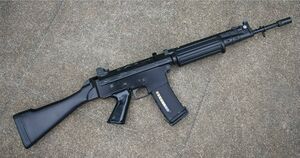IAR-60: Difference between revisions
No edit summary |
|||
| Line 1: | Line 1: | ||
{{infobox weapon | {{infobox weapon | ||
| name = IAR-60 | | name = IAR-60 | ||
Revision as of 14:04, 20 November 2019
| IAR-60 | |
|---|---|
 Early model IAR-60 | |
| Type | Assault rifle |
| Place of origin | |
| Service history | |
| In service | 1980 - Present |
| Used by | |
| Production history | |
| Designed | 1972 - 1978 |
| Manufacturer | Wilton-Nash Firearms Company |
| Variants | See Variants |
| Specifications | |
| Weight | 3.4 kg (7.5 lb) unloaded / 3.85 kg (8.48 lb) loaded |
| Length | 997 mm (39.25 in) Fixed Stock / 766 mm (30.15 in) Folded Stock |
| Barrel length | 450 mm (17.7 in) |
| Cartridge | 4.85×49mm |
| Action | Gas operated long-stroke piston, Rotating bolt |
| Rate of fire | 700 RPM |
| Muzzle velocity | 950 m/s (3,117 ft/s) |
| Effective firing range | 400m |
| Feed system | 35 round box magazine |
| Sights | Aperture rear sight, post front sight |
The IAR-60 is a select fire assault rifle developed by the Trinovantan Wilton-Nash Firearms Company. It was the standard service rifle for the Trinovantan Armed Forces until being replaced by the IAR-80 starting in 2009.
Development
Starting development in late 1972, the IAR-60 was created to address common complaints of the previous IAR-38 design that arose during [CONFLICT]. Chief among these complaints were concerns related to the IAR-38's 7x43mm ammunition. The IAR-38 vastly increased the volume of fire of a Trinovantan infantryman over the previously used IR-1, however this increase in volume of fire also lead to an increase in ammunition consumption. The 7x43mm cartridge was still too heavy to be effectively used in higher capacity magazines, and generated too much recoil to be effectively used in automatic fire. In order to facilitate higher volumes of fire, a longer cartridge was developed. The 4.85x49mm cartridge developed for this purpose was significantly less powerful, but was dramatically lighter and had a higher muzzle velocity than the 7x43mm cartridge it replaced. This had the added benefit of providing a flatter shooting trajectory, which made engaging point targets at longer ranges more comfortable for the shooter.
Trinovantan military trials of the rifle began in 1979, where the rifle was considered to be a notable improvement over the IAR-38. The weapon was accepted for service in 1980.
Design Details
While it bears a visual similarity to WN's previous IAR-38, the design of the IAR-60 has almost nothing in common with its predecessor, with the most notable change being from a Tilting Breechblock mechanism to a more conventional rotating bolt design. This design is more mechanically simple and reliable than the one used on the IAR-38. The rifle is equipped with a four-position fire selection lever on the left side of the receiver that also acts a safety. The four positions are "S" (safe), "1" (single-shot), "3" (three-round burst), and "A" (automatic).
The barrel bore, firing chamber, gas port block, and gas piston head are chrome-plated to reduce the effects of propellant fouling. The barrels come equipped with a flash suppressor which also acts as an adapter to fire rifle grenades. A two-position gas valve facilitates this functionality. The gas valve switch, when pulled into the upright position to isolate the gas system, acts as a sight for aiming the rifle grenade. This rifle grenade functionality was considered to be an interim solution until an accompanying under-barrel grenade launcher, designated OG-60, was developed for the rifle and accepted into service in 1983. A bayonet lug is present, with an accompanying spike bayonet that fits around the flash hider produced for the rifle.
The upper receiver of the IAR-60 is made from stamped steel, while the lower receiver and magazine housing is made from an aluminium alloy. The weapon feeds from a 35-round steel magazine. This magazine, when loaded, is approximately the same size as and weighs slightly less than a loaded 20 round magazine used by the IAR-38. The rifle itself is also over a kilogram lighter than the IAR-38. These two factors allow an infantryman issued an IAR-60 to carry significantly more ammunition for a given weight compared to the IAR-38 or other rifles that use larger, more powerful cartridges. The IAR-60 is generally issued with a lightweight alloy folding stock, though a fixed polymer stock available for use as well. Both front and rear sights are adjustable. The rear sight has two different apertures for shooting at distances of 200 meters and 450 meters, while the front post can be adjusted for elevation. Adapters also exist for optical sights, the most common of which is a 3.5x magnification mid-range optic.
Variants
Military
- IAR-60 - Full-length service rifle
- IACR-60 - Carbine-length rifle
Civilian
- WN R78 - Civilian-Spec Semi-Auto rifle
- WN R78A - Mil-Spec rifle for civilian sales
